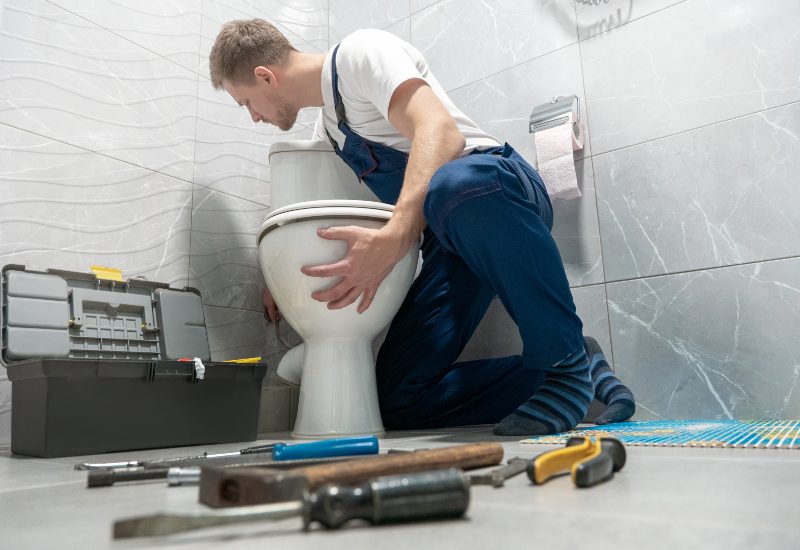
Toilet troubles are highly inconvenient, stressful, and embarrassing. Problems related to the toilet flange are common but surprisingly not well-known. If your toilet is acting up, use this guide to help determine if the flange is to blame and, if so, how to fix it.
Understanding the Toilet Flange
The flange located at the base of the toilet is a vital part that connects this fixture to the sewer line. Toilet flanges are typically made of plastic, cast iron, or brass and hold the toilet securely to the floor, preventing leaks and ensuring a seamless flow of waste into the sewer system.
Given the moist environment and stress it endures, it’s no surprise that the toilet flange deteriorates over time. The difficult part is that toilet flange repair isn’t as simple as changing a light bulb. It requires carefully disconnecting and removing the toilet, accurately placing a new flange, and reinstalling the toilet. Mistakes can cause leaks and property damage, so it’s best to let a plumbing professional tackle this job.
Signs You Should Call a Seattle Plumber to Replace Your Toilet Flange
Now that you understand the toilet flange’s purpose, you might wonder how to tell when this key component requires attention. Here are some signs that you should call a plumber to take a look:
- Wobbly toilet: If your toilet rocks back and forth or feels unstable when you sit on it, this could mean the flange isn’t holding the fixture down securely. The instability can further damage the flange and cause leaks.
- Persistent sewer odors: The bathroom often isn’t the freshest-smelling room in the house, but a constant foul smell could indicate leaking sewer gases. An improperly sealed or damaged flange fails to contain these odors, causing unpleasant smells to persistently waft up from the sewer line.
- Standing water around the toilet: The flange’s primary function is to create a watertight seal between the toilet and the sewer line. If it’s compromised, water may leak around the base of your toilet with every flush. If you see a puddle on the floor, wipe it up and flush the toilet to see if that’s the cause. A leaky toilet base isn’t just a nuisance; it’s a health hazard that can lead to more extensive damage if not addressed promptly.
- Loose tiles or spongy floor around the toilet: Closely examine the floor around your toilet. Are tiles coming loose tiles? Does the floor feel soft or spongy? These symptoms could indicate a slow, long-term leak from a failing toilet flange. Over time, this can cause the subfloor to rot and weaken.
- Leaks in the ceiling below the bathroom: If your toilet is on an upper floor and you notice water stains on the ceiling of the room directly below it, this is a clear sign that something is wrong with the bathroom plumbing. Combined with the other signs listed above, you can bet the toilet flange isn’t sealed correctly, allowing water to drip to the lower level.
The Basics of Toilet Flange Replacement
Unless you have extensive plumbing knowledge, you should leave toilet flange repair to a professional plumber. Even so, you may be curious about what the job entails. Here’s what to expect:
- Disconnect and remove the toilet: After shutting off the water supply, the plumber unfastens the closet bolts securing the toilet to the floor. It’s then possible to carefully lift and remove the toilet, placing it off to one side.
- Remove the old flange and wax ring: Once the toilet is removed, the existing flange and wax ring become accessible. The plumber removes these and thoroughly cleans the area to eliminate any remaining wax or debris that could interfere with installing the new components.
- Replace the wax ring and flange: Next, the plumber positions a new wax ring and secures a new flange over it. This might involve using an offset toilet flange or a toilet flange extender, depending on the height of your bathroom floor and the sewer pipe alignment. Proper positioning and a secure attachment are critical for ensuring a good seal and preventing leaks.
- Re-set and reattach the toilet: The plumber carefully sets the toilet onto the new flange and wax ring, tightening the closet bolts to ensure a secure and level installation. It’s important not to over-tighten the bolts, which could crack the toilet or deform the wax ring.
- Turn the water back on and check for leaks: The final step is to restore the water supply, allow the tank to fill, and flush the toilet a few times to check for leaks.
Consider hiring a plumber to replace the toilet flange every six to seven years as a preventative measure. This way, you keep the flange in good condition to avoid inconvenient leaks and property damage. The exact replacement timeline varies depending on the flange material and the conditions in your bathroom. Ask your plumber for a professional recommendation.
Get Help with Toilet Flange Leaks
Dealing with a leaky toilet flange doesn’t have to be a DIY nightmare. Puget Sound Plumbing and Heating is at your service for toilet repair in Seattle.
As a family-owned business with over 20 years of experience, we’re committed to delivering unbeatable work and ensuring a positive customer experience. We understand the importance of a swift, efficient response to plumbing emergencies, which is why our skilled and fully licensed technicians are available 24/7. Don’t risk the health and safety of your home—call us at (206) 938-3219 or contact us online to schedule toilet flange repair today.


